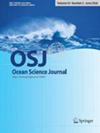海龟摄入的塑料碎片的特征:综合综述
IF 1.4
4区 地球科学
Q3 MARINE & FRESHWATER BIOLOGY
引用次数: 0
摘要
海龟作为一种具有重要生态意义的海洋物种,正面临着日益严重的塑料摄入威胁。为了制定有效的缓解策略,对摄入塑料的特性有细致入微的了解是至关重要的。以前的审查主要集中在发生的频率(%FO)和摄入的塑料量。在这项研究中,我们提出了一个更新的文献%FO和摄入塑料的数量,并介绍了形态,颜色和摄入塑料的聚合物组成的新综述。这项分析参考了110篇关于海龟摄入塑料的学术文章。此外,我们还探讨了摄入塑料的数量和特征的地理差异。大多数被分析的研究是在美洲和欧洲进行的。我们发现,大约54%的被检查海龟摄入了塑料碎片。红海龟比绿海龟摄入更多的泡沫(Wilcoxon秩和检验,p <0.05)。相比之下,绿海龟对电影的摄取量更高(Wilcoxon秩和检验,p >0.05)。我们的研究还强调了关于摄入塑料的原始使用数据的缺乏。白色和透明塑料最常被摄入。此外,还经常发现密度低于海水的聚合物,如聚乙烯、聚丙烯及其共聚物。我们强烈建议未来的研究提供更全面的数据关于摄入的塑料,包括数量,形态和化学性质,和来源。这些详细的信息对于制定明智和有效的策略来对抗海洋生物的塑料摄入是必不可少的。本文章由计算机程序翻译,如有差异,请以英文原文为准。
Characteristics of Plastic Debris Ingested by Sea Turtles: A Comprehensive Review
Abstract Sea turtles, an ecologically vital marine species, face the mounting threat of plastic ingestion. To devise effective mitigation strategies, a nuanced understanding of the characteristics of ingested plastics is essential. Previous reviews have predominantly concentrated on the frequency of occurrence (%FO) and quantity of ingested plastics. In this study, we present an update to the literature on %FO and quantity of ingested plastics and also introduce a novel review of the morphology, color, and polymer composition of ingested plastics. This analysis draws upon 110 scholarly articles on plastic ingestion by sea turtles. Additionally, we explore geographical variations in both the quantity and characteristics of ingested plastics. Most of the analyzed studies were conducted in the Americas and Europe. We found that approximately 54% of examined sea turtles had ingested plastic debris. Loggerhead sea turtles ingested more foams than green sea turtles (Wilcoxon rank-sum test, p < 0.05). By contrast, green sea turtles exhibited a higher ingestion on films (Wilcoxon rank-sum test, p > 0.05). Our study also underscored the paucity of data regarding the original usage of ingested plastics. White and transparent plastics were most commonly ingested. Additionally, polymers with a lower density than seawater, such as polyethylene, polypropylene, and their copolymers, were frequently found. We strongly advocate for future studies to furnish more comprehensive data regarding the ingested plastics, including quantities, morphological and chemical properties, and origins. Such detailed information is indispensable for shaping well-informed and effective strategies to combat plastic ingestion in marine life.
求助全文
通过发布文献求助,成功后即可免费获取论文全文。
去求助
来源期刊

Ocean Science Journal
MARINE & FRESHWATER BIOLOGY-OCEANOGRAPHY
CiteScore
2.60
自引率
0.00%
发文量
43
期刊介绍:
Ocean Science Journal is a scientific journal published quarterly (30th March, June, September, December) by the Korean Society of Oceanography (KSO) and Korea Institute of Ocean Science & Technology (KIOST).
OSJ is international and interdisciplinary. Research articles, reviews and notes dealing with physical oceanography, biological oceanography/marine biology, chemical oceanography/marine chemistry, geological oceanography/marine geology, and marine pollution will be considered.
Ocean Science covers the following fields:
• physical oceanography: waves, currents, air-sea interaction, ocean modeling, coastal processes, water masses
• biological oceanography/marine biology: plankton, benthic organisms, fish, ecology, molecular biology
• chemical oceanography/marine chemistry: trace elements, isotopes, nutrients, organic substances, gases
• geological oceanography/marine geology: geophysics, sedimentology, paleontology, paleogeopraphy, sediment dynamics
• marine pollution: pollutants analysis and monitoring, fates of contaminants, aquatic toxicology, ecotoxicology
• Promotes all aspects of ocean science, experimental, theoretical and laboratory researches
OSJ aims to publish a very high quality scientific journal for researchers and other interested people throughout the world.
 求助内容:
求助内容: 应助结果提醒方式:
应助结果提醒方式:


